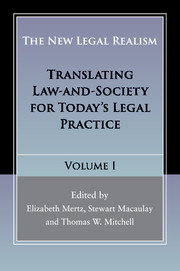Book contents
- Frontmatter
- Contents
- List of contributors
- Preface to The New Legal Realism, Volumes I and II
- 1 Introduction: New Legal Realism: Law and Social Science in the New Millennium
- Section I THE PLACE OF NEW LEGAL REALISM IN LEGAL THOUGHT AND TEACHING
- Section II PHILOSOPHY AND METHODS FOR A NEW LEGAL REALISM
- Section III NEW LEGAL REALIST TRANSLATIONS
- 10 New Legal Realism and Inequality
- 11 The Financial Crisis and Moral Accountability: Translating Practices of Risk, Profit, and Uncertainty
- 12 The Moment of Possibles: Some New Legal Realism about a “Reality Thriller” Case
- 13 Translating Law across Cultures and Societies: A Conversation with David Bellos and Kim Lane Scheppele
- 14 Is There a Lingua Franca for the American Legal Academy?
- Index
- References
12 - The Moment of Possibles: Some New Legal Realism about a “Reality Thriller” Case
from Section III - NEW LEGAL REALIST TRANSLATIONS
Published online by Cambridge University Press: 05 May 2016
- Frontmatter
- Contents
- List of contributors
- Preface to The New Legal Realism, Volumes I and II
- 1 Introduction: New Legal Realism: Law and Social Science in the New Millennium
- Section I THE PLACE OF NEW LEGAL REALISM IN LEGAL THOUGHT AND TEACHING
- Section II PHILOSOPHY AND METHODS FOR A NEW LEGAL REALISM
- Section III NEW LEGAL REALIST TRANSLATIONS
- 10 New Legal Realism and Inequality
- 11 The Financial Crisis and Moral Accountability: Translating Practices of Risk, Profit, and Uncertainty
- 12 The Moment of Possibles: Some New Legal Realism about a “Reality Thriller” Case
- 13 Translating Law across Cultures and Societies: A Conversation with David Bellos and Kim Lane Scheppele
- 14 Is There a Lingua Franca for the American Legal Academy?
- Index
- References
Summary
INTRODUCTION
A familiar realist principle holds that legal processes do not just influence social events or attitudes, but vice versa as well. As a “contextualist” (Nourse and Shaffer 2009, 79), “pragmatist” (Suchman and Mertz 2010) contribution to contemporary New Legal Realism, this chapter employs the linguistic branch of legal anthropology that has shown that this back-and-forth occurs through what people say (semantics) and how they say it (pragmatics) during inexact translations across the filter between law and society (e.g., Conley and O'Barr 2005; Ng 2009). In particular, it builds upon research that has explicitly extended pragmatist philosopher Charles Peirce's semiotic theory to legal reasoning – especially, but not only, in court. This approach elucidates the realist insight by connecting the micro-linguistic aspects of something like courtroom interaction to the macro-discursive level of law as an institution.
The specific connection I pinpoint is a moment in legal interaction that harbors the joint possibility of coordinated argumentation and professional legitimization. Even the most disputatious participants in legal argumentation must coordinate some framework to govern what and how they dispute. I argue that the ephemeral gap between two speakers’ turns is a moment of interpretive possibility as to knowledge about law and a moment of interpersonal (or “intersubjective”) possibility as to the experience of doing law. That simultaneity makes this moment also a source of professional legitimization, such as through the potential for persuasion; potential, because it rests on continually reshaping a shared institutional framework as much as on convincing interlocutors of a propositional argument.
I elaborate by analyzing the summary judgment motion in a copyright infringement case, Threshold Media Corp. v. Relativity Media, LLC (CV-10–9318-DMG, C.D. Cal. 2010). The case involved a film, Catfish, that caused social controversy over its “realness” immediately upon its premiere at the 2010 Sundance Film Festival (Buchanan 2010). Elsewhere, I have described how the legal professionals reproduced that controversy, translating realness into copyright's central criterion of originality (more precisely, original expression) (Deeb 2016). The realness controversy was triggered by Catfish's saturation with new media characteristics. That thoroughness disrupted generic expectations of documentary versus scripted film, which reflected a deeper blurring of cultural genres for interpreting mediated experience in a new media age. The disruption also precluded the legal professionals from simply applying the originality criterion to the artistic facts in question according to long-established jurisprudential habits.
- Type
- Chapter
- Information
- The New Legal RealismTranslating Law-and-Society for Today's Legal Practice, pp. 244 - 265Publisher: Cambridge University PressPrint publication year: 2016



